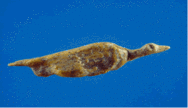| ||
WASHINGTON DC - In Germany, scientist have recently discovered what is now thought to be the world’s earliest example of human sculpture. We can’t help but marvel at the artistic level of the people of the ancient world.
On December 18, 2003, the most recent edition of Nature published the newest example in the field of archaeology. Archaeologist Nicholas Conard of the University of Tubingen University, Germany found a set of ivory carvings dating back to 30,000 years ago in the Hohle Fels Cave from a far out countryside in the Swabia region of southwest Germany. These figurines are approximately two centimetres in height and their modelling depicts the remarkable creativity of European art 30,000 years ago.
This discovery, along with the human remains found previously in the Swabia region, are the earliest human relics found up to this day. No wonder archaeologist Anthony Sinclair of the University of Liverpool, UK says, “Without question, they are the oldest examples of figurative art in the world.”
This set of figurines, carved via flint tools, consists of a water bird, a half-man, half-cat creature, and a horses head. It is still unclear to scientists what these sculptures actually mean. “We do not know exactly how and why art developed as it did. Many aspects of human evolution are dictated by the historical setting in which they occur. Still it seems that once symbolic communication started in the form of figurative representation, that it did not take long to develop a high level of artistry. The situation could have developed differently, but it does seem in fact that precise and beautiful representations are present from the start of figurative art,” says Conard.
The location of the carvings indicate that at that time humans mostly inhabited the area the Danube River and that the artistry at that period is very different from ours today. This discovery completely overthrows the traditional idea that art developed gradually from that of the primitive and rough style to the fine, contemporary craftsmanship today. "It seems that the first modern humans in Europe were astonishingly precocious in their skills," says Sinclair.
Conard also says, “We may need to abandon simple ideas about where and when cultural modernity arose. Different populations in Europe and elsewhere may have developed their styles independently.”
New archaeological findings continually renovates our previous understandings of evolution. After we excavate more of these types of evidence, we will be pressed to rewrite the history of human civilisation in the near future
* * *
You are welcome to print and circulate all articles published on Clearharmony and their content, but please quote the source.











 more ...
more ...